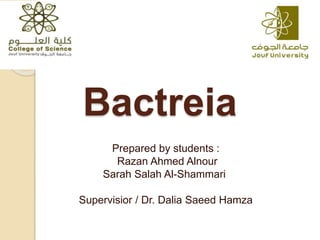Bacteria.pptxmmmmmmmmmmmmmmmmmmmmmmmmmmm
•Download as PPTX, PDF•
0 likes•2 views
microbiology
Report
Share
Report
Share

Recommended
More Related Content
Similar to Bacteria.pptxmmmmmmmmmmmmmmmmmmmmmmmmmmm
Similar to Bacteria.pptxmmmmmmmmmmmmmmmmmmmmmmmmmmm (20)
Introduction to microbiology, Bacterial Cell wall, Difference between Gram p...

Introduction to microbiology, Bacterial Cell wall, Difference between Gram p...
Introduction to microbiology & common microorganisms

Introduction to microbiology & common microorganisms
More from hend49
More from hend49 (12)
Ch1___Importance of Computers in Physics The Nature of Computer Simulations -...

Ch1___Importance of Computers in Physics The Nature of Computer Simulations -...
Recently uploaded
Xanthomonas axonopodis pv.citri is a bacterium that attacks citrus trees and flourishes in locations with high temperatures, rains and strong winds. In places with these features, X. axonopodis pv.citri produces citrus canker, resulting in significant economic losses for citrus companies. It spreads by the unintentional movement of diseased citrus fruits and seedlings to uninfected areas.Virulence Analysis of Citrus canker caused by Xanthomonas axonopodis pv. citr...

Virulence Analysis of Citrus canker caused by Xanthomonas axonopodis pv. citr...TALAPATI ARUNA CHENNA VYDYANAD
Recently uploaded (20)
GBSN - Microbiology (Unit 7) Microbiology in Everyday Life

GBSN - Microbiology (Unit 7) Microbiology in Everyday Life
WASP-69b’s Escaping Envelope Is Confined to a Tail Extending at Least 7 Rp

WASP-69b’s Escaping Envelope Is Confined to a Tail Extending at Least 7 Rp
Soil and Water Conservation Engineering (SWCE) is a specialized field of stud...

Soil and Water Conservation Engineering (SWCE) is a specialized field of stud...
Heat Units in plant physiology and the importance of Growing Degree days

Heat Units in plant physiology and the importance of Growing Degree days
Adaptive Restore algorithm & importance Monte Carlo

Adaptive Restore algorithm & importance Monte Carlo
Isolation of AMF by wet sieving and decantation method pptx

Isolation of AMF by wet sieving and decantation method pptx
THE GENERAL PROPERTIES OF PROTEOBACTERIA AND ITS TYPES

THE GENERAL PROPERTIES OF PROTEOBACTERIA AND ITS TYPES
Factor Causing low production and physiology of mamary Gland

Factor Causing low production and physiology of mamary Gland
Virulence Analysis of Citrus canker caused by Xanthomonas axonopodis pv. citr...

Virulence Analysis of Citrus canker caused by Xanthomonas axonopodis pv. citr...
short range interaction for protein and factors influencing or affecting the ...

short range interaction for protein and factors influencing or affecting the ...
Bacteria.pptxmmmmmmmmmmmmmmmmmmmmmmmmmmm
- 1. Bactreia Prepared by students : Razan Ahmed Alnour Sarah Salah Al-Shammari Supervisior / Dr. Dalia Saeed Hamza
- 2. Bacteria Bacteria form a group of organisms primitive nuclei, treated by man without seeing them, it has been known to cause disease and used some of them in various fermentation processes . And the discovery of the microscope had a great impact on her identification. Definition of bacteria: They are unicellular microorganisms that have everything they need to do all the basic functions of life.
- 3. General properties of bacteria 1 )primitive micro-organisms nuclei. 2) featuring simple structure It is formed from a cell wall and membrane surrounding the cytoplasm that contains a single ring chromosome DNA 3) its wall hardness comes for the presence of a polypeptide 4) multiply by simple binary fission 5) in order for bacteria cells to be clearly seen under a microscope, we need to use different
- 4. Forms of bacteria A) spherical bacteria :They may be single or chain- shaped, such as pneumonitis bacteria, or bilateral, quadruple, or more irregular clusters . B) Bacillus bacteria :They may be single, chain- shaped or receptive in shape, such as cholera bacteria . C) spiral bacteria :They are the largest, like the bacteria of syphilis .
- 5. Types of bacteria based on their way of nutrition A) Autotrophic: are bacteria that make food needs for them from their primary sources may use the light energy so called photo autotrophic or use chemical energy so called chemo autotrophic . B) B) Heterotrophic: non-self-feeding bacteria usually live within living organisms
- 6. Benefits of bacteria - Analyze the bodies of dead creatures to feed on them. - Fixation of atmospheric nitrogen in the root cells of certain plants. - - Used in the manufacture of a lot of food such as: vinegar, some types of cheese, turn milk into milk - Extraction of primitive starch from the roots of plants.
- 7. Author: Dr.. Mohamed El-Sawy Mohamed Mubarak Dr.. Abdelwahab Mohamed Abdelhaf Dr.. Rawya Fathi Jamal Publication year 2005 Book name: The world of bacteria Publisher: Osiris Library